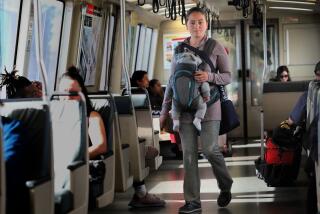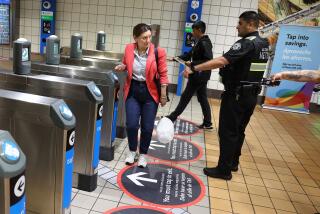Old meters made to aid homeless
- Share via
BALTIMORE — With just a coin, people can help turn despair into hope.
New parking meters, debuting today in downtown Baltimore, are part of the city’s freshly launched effort to erase homelessness in 10 years.
These old-fashioned meters, which Baltimore began retiring last year, have reemerged with bright paint and a new mission. They have nothing to do with parking fines and everything to do with getting people off the street.
The city’s Downtown Partnership created the plan, which appears to be the first of its kind in the country, as part of an anti-panhandling initiative.
“The idea here,” said Tom Yeager, a Downtown Partnership executive vice president, “is to educate the public that it’s OK to give, but we just want you to give where you’re helping to make a change.”
When someone drops a nickel, dime or quarter into one of the “Make a Change” meters, a pointer on the dial slowly shifts from “despair” to “hope.” You don’t get any more hope for a quarter than a nickel, and to completely ward off despair, someone would have to stand at the machine forever with a bottomless bag of change.
In any case, every coin will go to programs run by Baltimore Homeless Services Inc.
Downtown Partnership spokesman Mike Evitts said the visual swing between despair and hope and back again, although something of a downer, is designed to have people reaching into their pockets again and again.
“It’s to show that every dime helps,” he said, “but the need out there is very great.”
City Council President Sheila Dixon and Health Commissioner Joshua M. Sharfstein announced Tuesday that they would reveal a plan by June to defeat homelessness citywide.
Dixon, soon to succeed Maryland Gov.-elect Martin O’Malley as mayor, reminded people of grim statistics: 2,943 homeless people were counted in Baltimore one night last winter.
“That’s human beings living in shelters and on the streets of Baltimore,” she said, adding that four out of five were men, four out of five were black, one-third were veterans, and the average age was 44.
“This was a terrible picture for a city making so much progress,” she said. “It is a picture that must be changed.”
Baltimore is one of hundreds of cities around the country setting timelines to end their homelessness problems.
Some have made progress, including Philadelphia, where officials say homelessness has dropped by 60% during the last five years.
Philadelphia attributes its success to a program known as “housing first,” in which homeless people are put into subsidized housing where they then get help with substance abuse and mental health problems.
Baltimore is testing its version of that program with 25 people.
Meanwhile, if the nine meters installed on sidewalks along Pratt Street between Harborplace and Oriole Park at Camden Yards raise money or seem to curb panhandling, Downtown Partnership might add more across town.
Although wiping out homelessness within a decade is an ambitious goal, Dixon said Baltimore was up to the challenge, particularly if government combined forces with nonprofit organizations, faith-based groups and the business community.
“I don’t think we’re saying there won’t be any shelters in Baltimore in 10 years,” Sharfstein said. “But you can’t not try.”
More to Read
Sign up for Essential California
The most important California stories and recommendations in your inbox every morning.
You may occasionally receive promotional content from the Los Angeles Times.













